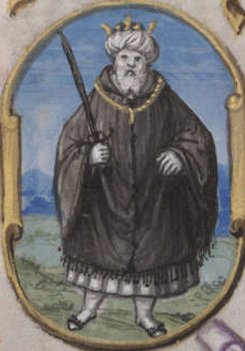 Why the slash? The slash in the years of Pelagius’ reign was the first thing that I noted when looking at the genealogical table above. Sometimes my head spins when I look at historical graphs like this with all the unfamiliar names and dates. If you feel the same way, here’s a tip: Try to pick out one thing that you do recognize. A name. A date. I noticed the slash.
Why the slash? The slash in the years of Pelagius’ reign was the first thing that I noted when looking at the genealogical table above. Sometimes my head spins when I look at historical graphs like this with all the unfamiliar names and dates. If you feel the same way, here’s a tip: Try to pick out one thing that you do recognize. A name. A date. I noticed the slash.
Then make that one thing your reference point, and after that, you may start identifying other things. Here are four items that I noted and labeled with the yellow arrows – appropriate for Camino Primitivo, eh?
1.) The slash.
Pelagius is the first King of Asturias, and his name can be found at Arrow 1 in the upper left of this chart that looks sort of like a family tree. It is a family tree of sorts, which displays the lineage of Asturian royalty. The years shown in parenthesis after the rulers’ names are the years of their reign, not their life span.
The slash reminded me that I read that there was a dispute over the date of the inception of the Kingdom of Asturias. The date of the establishment of the small, Christian state is based on the year of a revolt against the Arabs at Covadonga. While most sources say that the insurrection happened in 718, some have dated it as 722. Hence, the slash. In this table, the slash in 718/722 means that Pelagius became the first king of Asturias in 718 or 722, after leading his people to victory against the Arabs, who by the way, had invaded the Iberian peninsula in 711. Pelagius (Latin), or Pelayo (Spanish) is considered to have started the Christian Reconquista.
 Estatua de Pelayo (Covadonga) by Tony Rotondas, Wikimedia Commons Attribution ShareAlike 3.0 (Generic). Look at those craggy Asturian mountains. Are those steep mountain trails the cause for his thick thighs?
Estatua de Pelayo (Covadonga) by Tony Rotondas, Wikimedia Commons Attribution ShareAlike 3.0 (Generic). Look at those craggy Asturian mountains. Are those steep mountain trails the cause for his thick thighs?
2.) Alfonso II
Alfonso II “The Chaste” is the guy who upon hearing the news of the discovery of the tomb of St James in Galicia around 814, left Oviedo where he had established the seat of the state, and went to authenticate the finding. He built a simple wooden church at the site, “thereby thereby legitimising the claim.” (2) He is considered the “First Santiago Pilgrim” on the Camino de Santiago routes, and the route that he traveled is now called the “Camino Primitivo” or “Original Camino.”
3.) Why the dashed line?
The dashed line at Arrow 3 reminded me that Alfonso I, “The Catholic” had an illegitimate son, Mauregatus, who seized power in 783 when Alfonso II was the more likely candidate. (3) Alfonso was expelled by his cousin Mauregatus, “The Usurper,” but came back later and ruled in 791. So does the dashed line mean coup d’etat or bastard son? If you know, please leave a comment below.
 King Mauregatus (783-788) by Alonso de Cartagena [CC BY-SA 4.0 (http://creativecommons.org/licenses/by-sa/4.0)], via Wikimedia Commons. Nice shoes, bud!
King Mauregatus (783-788) by Alonso de Cartagena [CC BY-SA 4.0 (http://creativecommons.org/licenses/by-sa/4.0)], via Wikimedia Commons. Nice shoes, bud!
4.) Fruela – man or woman?
I used to think that Fruela was a woman’s name – probably because it ends in “a.” But no, I was wrong. Fruela was a man, and there were a few of them in this family tree.
The other thing that this table told me: the Kingdom of Asturias was short-lived. It was founded in 718 or 722 and ended 910. What did you glean from the Table of Asturias Succession? Leave a note below.
Camino Books and Footnotes:
- Table from Collins, Roger. Law, Culture and Regionalism in Early Medieval Spain (Variorum Collected Studies Series). First Edition, Variorum, Hampshire, GB, 1992, p. 303
- Dennett, Laurie. 2000 Years of the Pilgrimage, Confraternity of St James, London, 2005
- Collins, Roger. The Arab Conquest of Spain: 710 – 797. Oxford: Blackwell, 1989. p. 165-6
This blog, CaminoPrimitivo814, contains affiliate links. If you make a purchase through these links, Stacey earns a commission at no extra cost to you. These commissions help reduce the costs of keeping this travel blog active.
Further, as an Amazon Associate I earn from qualifying purchases. Thanks for reading.
Enjoy this article? I’d love to hear your thoughts in the comments section below. Please share this article with the social media buttons below.
To get more travel inspiration, simply subscribe below and updates will be delivered directly to your email inbox.
The Camino Primitivo is full of rich history. Please leave a comment or link to more historical or cultural tidbits. Buen Camino!
LikeLike